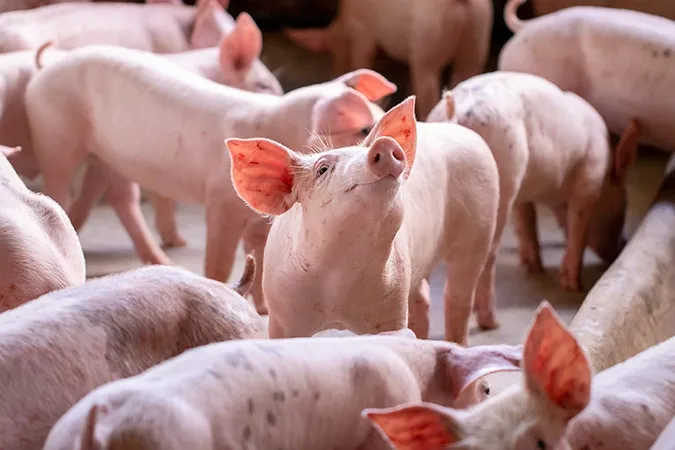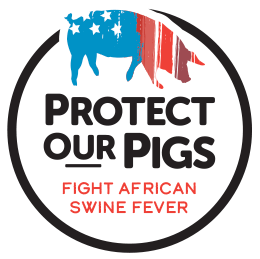With a 100% mortality rate and no vaccine for pigs, African swine fever poses a grave threat to commercial producers. While the virus has not been detected in the United States, international travel, trade, and the disease’s easy transmission puts your herd at risk. It’s important to remain vigilant, practice and enforce proven prevention steps, and enhance your farm’s biosecurity plans and practices.
How Transmission Can Occur
Although people cannot get African swine fever, they can carry it on clothing, shoes, and equipment. Sources of the infection include garbage feeding, contaminated personnel, equipment and vehicles, contaminated feed, or water, infected domestic or wild pigs, soft ticks, stable flies and semen. The most common sources of transmission include:
Direct contact occurs when healthy pigs have contact with infected domestic or wild swine or come in contact with infected saliva, urine, feces, or aerosolized respiratory secretions via coughing or sneezing.
Indirect transmission happens when healthy pigs eat virus-contaminated feed, pork products, or come into contact with the virus on clothing, shoes, equipment, vehicles, or food waste.
6 Key Prevention Steps
The USDA is working closely with other Federal and State agencies, the swine industry, and pork producers to take the necessary actions to protect our nation’s pigs and keep this disease out of the United States. Don’t let anyone bring disease to your farm. Communicate and enforce the following critical steps to protect your herd.


Step 6: Ask visitors about recent international travel.
Don’t let anyone who has been in an African swine fever-affected country onto your farm for at least 5 days after returning to the United States.

Step 5: Clean and disinfect all equipment and vehicles entering or leaving your site.
The virus can stay on vehicles and equipment. Follow specific cleaning and disinfection protocols for both animal and non-animal transport vehicles.

Step 4: Prohibit anyone eating in animal areas.
The African swine fever virus survives for extended periods in pork and pork meat products and can be a source of spread. Keep all outside food products confined to a specific area of the facility away from animals.

Step 3: Wear clean coveralls and boots at each site.
Because the virus can stay on clothing, this step limits disease spread for anyone moving among different sites. Also, require visitors to wear clean clothes and shoes at all pig production facilities and farms.

Step 2: Require workers and visitors to routinely wash hands or shower-in and shower-out.
Have clear lines of separation between outside (dirty) and inside (clean) areas. Ensure all individuals follow correct protocols and remove all clothing and accessories on a designated dirty side and dress only in laundered items on the clearly marked clean side.

Step 1: Limit on-farm traffic.
Keep detailed records of all people, vehicles, and equipment at your farm and all pig production facilities. Regularly communicate prevention practices so everyone, especially new employees and those who speak English as a second language, are clear about rules.
Step Up Your Biosecurity






Update your biosecurity plan and implement an ongoing African swine fever training program for personnel.
Your site’s biosecurity manager is responsible for developing and updating an enhanced written biosecurity plan with the help of your herd veterinarian. This person is accountable for training and communicating biosecurity measures in a language each person who enters the site can understand. Also, the biosecurity manager and key personnel need to be trained themselves about biosecurity measures to keep the virus out.
Download Biosecurity Steps
English (1.68 MB) | Español (1.54 MB)
Restrict access to production sites.
Limit your site’s entry points and protect each with lockable gates. Lock buildings when no one is present. Establish a perimeter buffer area (PBA) to serve as an outer barrier around buildings to limit movement of the virus near animals. Designate a clearly marked parking area outside the PBA. People and vehicles moving through PBA access points must follow cleaning, disinfection, and other biosecurity measures. Also, create one or more line(s) of separation (LOS) as a control boundary to prevent movement of the virus into animal areas.
Enhance employee biosecurity practices.
Limit access to people who are essential to your production site. Everyone crossing the line of separation (LOS) arrives having showered and wearing clean clothing and footwear. Ensure all individuals crossing that line have signed an agreement to follow the rules. Require those crossing a LOS access point to complete an entry logbook, and that the logbook is monitored, and information is maintained. All individuals crossing at designated areas must follow biosecurity plan procedures.
Ensure strict movement-of-animal protocols.
Pigs and semen, if applicable, come with documented and verified sources of having no foreign animal disease. No animals from a regulatory-controlled area can be introduced onto the site for at least seven days before moving any animals to another pork production site with animals. You must have a contingency plan for interrupted animal movement. Animals leaving the production site can only move in one direction across any line of separation at one time. Contaminated areas must be cleaned and disinfected.
Prevent feed contamination and control wildlife, rodents, and flies.
Ensure that grain and feed are delivered, stored, mixed, and fed in ways to prevent contamination. Clean up and dispose of feed spills immediately to prevent wildlife attention. Also, make sure your facilities are designed to prevent all animals, including birds, from crossing into secure areas and contacting pigs. Maintain those areas and ensure that everyone works to support the documented rodent and fly control programs.
Put in place proper carcass disposal and manure management practices.
Dispose of dead animals to prevent the attention of wildlife, rodents, and other scavengers. Ensure rendering vehicles don’t enter the perimeter buffer area. Manure should be removed to prevent exposure of your herd to disease agents. Have a plan for where to store manure on-site if it cannot be moved off-site as a result of an outbreak.






Report Any Signs

Immediately report animals with any signs to State or Federal animal health officials or call USDA for appropriate testing and investigation.




